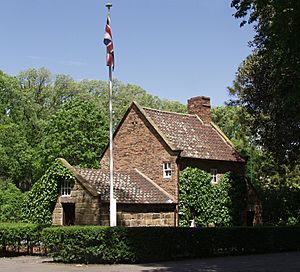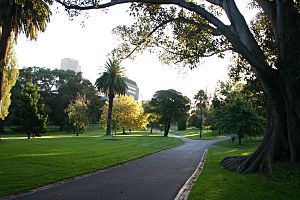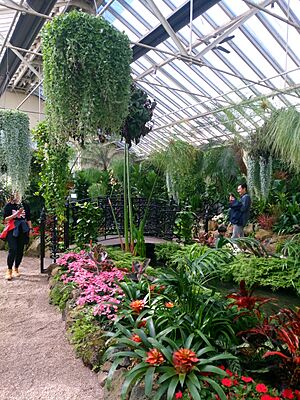Fitzroy Gardens facts for kids
The Fitzroy Gardens are a large park covering 26 hectares (about 64 acres) in East Melbourne, Victoria, Australia. They are located right next to the Melbourne Central Business District. This beautiful park is surrounded by Clarendon Street, Albert Street, Lansdowne Street, and Wellington Parade. The Treasury Gardens are just across Lansdowne Street to the west.
These gardens are considered one of Australia's most important Victorian era landscaped gardens. They help make Melbourne known as the "garden city" of Australia. Inside the gardens, you'll find many interesting things. There's a pretty ornamental lake, a special scarred tree, and a visitor center with a cafe. You can also see a conservatory filled with plants, and Cooks' Cottage. This cottage belonged to the parents of Captain James Cook and was brought all the way from England in the 1930s! The gardens also feature tree-lined paths, a tiny model Tudor village, a band pavilion, a rotunda, the famous "Fairies' Tree," and various fountains and sculptures.
Contents
Amazing Trees and Plants

One of the most special things about the Fitzroy Gardens is the many trees that line the pathways. They create beautiful green tunnels to walk through.
Long ago, this land was quite wet and swampy. A small creek flowed through it, draining into the Yarra River. The gardens were first designed by Clement Hodgkinson. A gardener named James Sinclair then planted many trees, making it a dense woodland with winding paths. The creek was decorated with ferns and willow trees. However, for many years, the creek smelled bad because of sewage from nearby houses. It was used to water the western part of the gardens for about 50 years. In the early 1900s, the creek water became much cleaner after new sewer pipes were installed in East Melbourne homes.
In the beginning, fast-growing blue gums and wattles were planted. These trees helped block the wind. Elm trees were also planted to create long avenues along the paths. Interestingly, these elm tree paths ended up forming a pattern that looked like the Union Flag!
Clement Hodgkinson, the designer, wanted the gardens to provide lots of shade. He also wanted thick groups of trees to stop dust from the busy streets from blowing into the park. He explained that because the paths were important for people to walk on, they had to line them with shady trees. They also planted many evergreen shrubs and fern trees in the background. Smaller flowering plants were added to make the grass look nicer in summer.
During the 1880s and 1890s, many blue gum trees were removed. This made more space for the other trees to grow. It also allowed for large, open lawns and pretty flowerbeds. The gardens started to feature more subtropical plants, especially in areas like the Mound and the Grey Street Walk.
More big changes happened in the 1930s and 1940s. The beautiful Conservatory was built, and Cooks' Cottage arrived in the gardens. In 2014, an old storage area was turned into a new garden space. This new area includes a system to collect rainwater and a modern cafe and visitor center. This center gives information about Melbourne and specific details about Cooks' Cottage and Fitzroy Gardens.
Why the Gardens are Special
The Fitzroy Gardens are listed on the Victorian Heritage Register. This means they are very important to the State of Victoria for many reasons. They have historical, artistic, architectural, scientific (for their plants), and social value.
The gardens are historically important because they are one of several public parks created around Melbourne in the 1800s. These parks offered a place for people to relax and enjoy nature. Fitzroy Gardens is seen as the most important of these city parks. Others include the Flagstaff, Treasury, Carlton, and Alexandra Gardens, and the Kings Domain. These gardens remind us how much Melbourne invested in public green spaces. People in the 1800s believed that parks were good for people's health and spirits, especially in busy, sometimes dirty, cities.
The Fitzroy Gardens are also socially important. Since they were created in the early 1860s, they have been a place for people to relax, play quietly, and enjoy themselves. They are truly the "people's park" in the city.
The Scarred Tree
One very special feature in the gardens is a scarred tree. A plaque at the base of the tree explains its meaning:
- The scar on this tree was made by Aboriginal people.
- They removed bark from the tree to create many useful items. These included canoes, shields, containers for food and water, string, and baby carriers.
- This site is very important to the Wurundjeri people. They are the traditional owners of this land.
- It is also an important part of the history of all Australians.
- All Aboriginal cultural sites like this one are protected by law.
Who Lives in the Gardens?
The Fitzroy Gardens are home to many animals! You might spot brushtail and ringtail possums. There are also colorful rainbow lorikeets, ducks, and tiny microbats (which are small bats that eat insects). At night, large grey-headed flying foxes (bats that eat nectar and fruit) and powerful owls visit the gardens. Seeing Australian wildlife makes the city gardens a wonderful place for both visitors from other countries and local people.
A Look Back in Time
- 1848: The Fitzroy Gardens were officially set aside as public gardens. The State Government and the City of Melbourne shared ownership. The gardens were first called Fitzroy Square, named after Sir Charles Augustus FitzRoy, who was a governor of New South Wales.
- 1857: James Sinclair became the head gardener. He worked in the gardens until he passed away in 1881.
- 1860: The Lands Department took over managing the gardens. Clement Hodgkinson, who led the department, took a special interest in planning city parks, including Fitzroy Gardens.
- 1862: The network of paths was created, and a band pavilion was built.
- 1864: Sinclair's Cottage and a small Tudor-style gatekeeper's lodge were built.
- 1873: The "Temple of Winds," a rotunda in a classical style, was built.
- 1880: Many blue gum trees were removed.
- 1890: Every second elm tree on the avenues was removed to give more space.
- 1901: The plant nursery and stable yard were moved from the center of the gardens to their current spot.
- 1908: A timber-style Kiosk (a small shop) opened.
- 1915: The wooden picket fence around the gardens was replaced with stone edging.
- 1917: The City of Melbourne took over control of the gardens.
- 1927: The Plant Manager's house was built.
- 1930: The Conservatory, used for showing greenhouse plants, opened.

- 1934: Cooks' Cottage was put up in the gardens. It was bought, shipped to Australia, and given as a gift by the Grimwade family. Also, artist Ola Cohn finished carving the famous Fairies Tree and gave it to the children of Melbourne.
- 1960: The Kiosk was damaged by fire.
- 1960s: The central part of the creek was put into pipes underground.
- 1964: A new Kiosk opened.
- 1970s: An 18th-century style cottage garden was added next to Cooks' Cottage.






